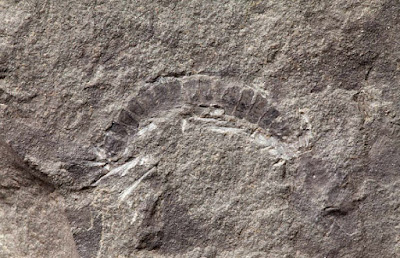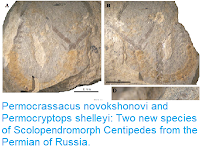Understanding how organisms colonised the land, is crucial to clarify extant biodiversity and biological adaptation. But, evaluating the rate and pattern of land colonisation requires precise dating of the fossil of early land biotas and reconciling them with evolutionary divergence based on morphology and molecular clocks. The frequent striking inconsistency between the ages of fossils and their phylogenies limits our understanding of macroevolution, and it reduces confidence in phylogenetic inference: this is especially the case for the first land Animals. Arthropoda (Insects, Spiders, Centipedes and their allies) were the first, and are the largest group of land Animals in both numbers and biomass. The first fossil land Arthropod-Plant assemblages are rare and only found in Late Silurian (about 425 million years old) to Early Devonian (about 410 million years old) equatorial terrestrial and freshwater sediments within and marginal to the ancient Caledonian mountains which stretched from New York to Germany. The earliest fossil land Arthropods are Myriapods (Millipedes and Centipedes) from the latest Silurian (about 425 million years old) of Scotland and Wales.
Yet, while Arachnid molecular phylogenies fit the fossils, Myriapod molecular clock phylogenies do not and suggest a late Cambrian (500 million years) monophyletic origin and divergence of the Myriapod classes, which implies not only a marine origin of the classes and possible independent land colonisation events during Myriapod evolution, but also that pre-late Silurian Myriapods are not preserved in the geological record. Though the first land Arthropods were initially very small with thin cuticle, and are difficult to preserve except under unusual conditions, nevertheless, there are enough organic-rich sediments with soft bodied fossils in appropriate environments in Cambrian to early Silurian times, that any existing land Arthropods would be at least occasionally preserved if present. But they are not. Apart from the doubtful Diplopod (Millipede), Casiogrammu ichthyeros, from the Hagshaw Hills, none occur in the Silurian Fish beds of the Midland Valley of Scotland, famed for their diverse freshwater Arthropods and oldest complete Fish fossils (but with no vascular plant remains), and currently assigned on fossils spores to the Wenlock (about 430 million years old). In any case, given that the dating of the Silurian Fish beds is so uncertain, this Diplopod? Could be the same age as or only slightly older than the Kerrera fossils, and similarly possibly aquatic. Pre-late Silurian tracks and trails of supposed land Arthropods are suspect and may represent, as is common today, only temporary excursion onto land. The earliest land Arthropod fossils are Millipedes associated with the first Vascular Plants in the latest Silurian (Pridoli) around 420 million years ago. But, while the earliest fossil Vascular Plant fossils are found at about 425 million years old (Upper Silurian), molecular phylogenies indicate a 515 million years old to 470 million years old (Late Ordovician-Silurian) origin. The precise timing of the appearance of the first land Arthropod and Plant fossils is difficult to determine because of the problem of correlating the deposits of the lakes, river and coasts, in which they occur, with the standard marine-based geological time scale, and there are almost no radiometric dates from associated sediments to help in this.
In a paper published in the journal Historical Biology on 15 May 2020, Michael Brookfield and Elizabeth Catlos of the Department of Geological Sciences at the University of Texas at Austin, and Stephanie Suarez of the Department of Earth and Atmospheric Sciences at the University of Houston, present the latest results in an ongoing study which aims to provide accurate dates for these first land biotas.
Brookfield et al. determined the ages of these first land arthropods, with uranium/lead dating of zircons in the earliest Millipede-bearing sediments from three places, in western England (Ludlow) and Scotland (Cowie, Kerrera). These sediments are associated with contemporary explosive volcanic activity, so the youngest concordant zircons give not only the maximum age of the enclosing sediment (a sediment cannot be older than the youngest thing in it, though it can be younger) but also a good estimate of the actual age of the sediment from the age of the contemporary volcanic rocks Zircons were separated from sediment samples taken either just above and below the arthropod-bearing beds (Kerrera and Cowie) or from heavy mineral separates obtained for other studies (Ludlow). Both the Kerrera and Ludlow dates are new. The Cowie date comes from an earlier study by Stephanie Suarez, Michael Brookfield, Elizabeth Catlos, and Daniel Stöckli, also of the Department of Geological Sciences at the University of Texas at Austin, and is included by Brookfield et al. to show the apparently rapid progressive coevolution of land Arthropods and Floras in semi-arid continental environments during the latest Silurian. The Kerrera Arthropods come from a temporary lake deposit with Anapsid Fish, interbedded with coarse semi-arid intermontane basin sediments, at the base of the Lorne Plateau Lavas. The only previous radiometric ages for Kerrera come from a lava at the top of the Lorne Plateau Lavas, 600 metres above the Kerrera sediments. Their uranium/lead zircon age of 425 ± 0.7 million years is a uranium/lead thermal ionisation mass spectrometry concordia age from two zircons which give individual ages of 425.4 ± 0.8 million years and 424.5 ± 0.8 million year. Zircons, however, are among the first minerals to crystallise from a cooling magma chamber, may be mixed populations from separate batches of magma, and can be several 100 000 years older than the lava eruption at the surface. The youngest concordant zircon gives a maximum age for the eruption of 424.5 ± 0.6 million years. The time taken for 600 metres of lavas to erupt is not known, but from other more recent similar lava piles, which accumulated over a fairly short time geologically, we can make an estimate. The average 1000 metre thick Grand Ronde Basalt lavas of the Miocene Columbia River Plateau were erupted over a 400 000 years period between 16.5 and 16.1 million years ago. A comparable duration is likely for the Lorne Plateau lavas, which seem to have erupted fairly continuously. Of the 52 zircons Brookfield et al. analysed, the youngest concordant ages were 426.5 ± 4.5 million years and 425.4 ± 4.8 million years, which are statistically indistinguishable. The 1 million years between the midpoints of the youngest Kerrera zircon and the youngest top Lorne Lava zircon is thus a reasonable estimate of the time taken for the Lorne Lava pile to accumulate.
The Ludlow Arthropods, accompanied by a fragmentary Cooksonia flora come from one organic-rich siltstone lens filling ripple troughs in fine sandstone just above the Ludlow bone bed lag deposit, a sandstone marking the change from shallow marine to semi-arid continental environments. Brookfield et al. analysed 29 zircons from heavy mineral concentrations, obtained for Conodont analysis, from two samples of the basal Bone Bed near Ludlow. Nineteen of these were within the expected latest Silurian (Pridoli) biostratigraphic age. The youngest dates of 420.0 ± 8.9 million years and 420.3 ± 8.1 million years are, like those from Kerrera, statistically indistinguishable. The Cowie dates of 413.7 ± 4.4 million years and 414.3 ± 7.1 million years which bracket the Millipede-bearing Fish bed, are younger than both the Kerrera and Ludlow.
These ages are consistent with the evolutionary stages shown by the fossil Millipedes and associated Arthropods.
The Kerrera and Ludlow Myriapods are Kampecarids which show no obvious structural adaptation to land. The Kerrera Kampecarids, Kampecaris obanensis and Archidesmus sp. occur with an early vascular ‘Cooksonia’ flora, Eurypterids and Anapsid fish in a freshwater lake deposit in a semi-arid fluvial environment. Kampecarids also sporadically occur in late Silurian to early Devonian freshwater lake environments throughout Scotland. The Ludlow Millipedes are also accompanied by the early vascular Cooksonia flora, and by a more diverse fauna of Arachnids, a Centipede and Eurypterids, eroded and redeposited either by a coastal storm deposit from a back-barrier environment or by a tsunami from more inland semiarid coastal plain environments. The most diverse Cowie Millipedes belong to the extinct Archipolyploda superorder and consist of Cowiedesmus eroticopodus which derives its name from preserved male gonopods, and Albadesmus almondi and Pneumodesmus newmani which do not have modified appendages preserved. Pneumodesmus newmani, however, has spiracles on the lateral parts of the sternites which are direct evidence of air breathing, and, before our dating, was taken to be the oldest fully terrestrial Animal. The Cowie deposit was laid down in a temporary lake environment related to braided and meandering streams in a semi-arid intermontane basin, but curiously, contains no identifiable Plant remains or spores. There is thus a progressive change in the Arthropod faunas across the Silurian/Devonian (Pridoli/Lochkovian series) boundary around 419 to 421 million years ago; from Kerrera (about 425 million years old, Ludlow series), through Ludlow (about 420 million years old, Pridoli series), to Cowie (about 414 million years old. Lochkovian series), and this increased diversification continues into younger more diverse early Devonian (Emsian) land biotas, like the Rhynie Chert intermontane basin hot springs biota from Aberdeenshire, and the Gaspé, eastern Canada and Alken, Germany, delta marsh biotas. The diverse Rhynie Chert, with an argon⁴⁰/argon³⁹ age of 407.1 ± 2.2 million years, has a diverse flora and fauna dominated by the Vascular Cryptogam Plants, Rhynia, Aglaophyton, and Horneophyton, and Arthropods; Arachnids (Trigonotarbida), Mites (Acariformes), Harvestmen (Opiliones), a possible Millipede (Diplopoda), Centipedes (Chilopoda), and Springtails (Collembola). Neither the Gaspé nor the Alken biotas have been dated radiometrically. But both have somewhat similar biota to Rhynie, despite their very different environment, with Vascular Cryptogams of the slightly more evolved Zosterophyllum flora, accompanied not only by Arachnids (Trigonotarbids), and Centipedes (Chilopoda), but also by freshwater Eurypterids and Anapsid Fish. By the Middle Devonian (about 385 million years ago), complex forests with ten-metre-tall trees and associated diverse arthropod communities had become established, for example at Cairo and Gilboa, New York. Nevertheless, the composition of the land biotas does not differ significantly from upland lake margins to delta front marshes from latest Silurian to mid-Devonian, a rapidly evolving successions of pioneer communities of Arthropods/Vascular Plants seems to have exploded over the Acadian landscape in a very few million years.
From fossil evidence, the time from initial colonisation by Arthropod-Vascular Plant communities to complex forest communities took place over less than 40 million years (425–385 million years ago). An essentially intermontane lake margin Pridoli FW/land biota in the Acadian mountains centred on Scotland evolved rapidly and migrated, undoubtedly via rivers, to colonise floodplain marshes in the adjacent lowlands by the Emsian, as there is little difference in contemporary biotas. Molecular phylogenies of the Myriapods, however, indicate a monophyletic origin and divergence about 100 million years earlier, while the origin of Vascular Plants is similarly placed from 100 to 50 million years prior to their first body fossils. Which is correct?
Though non-Vascular Plants and possibly amphibious Arthropods were around in the Ordovician, the fossil evidence is clear that Vascular Plant/land Arthropod biotas evolved together in the Late Silurian (about 425 million years ago) and not earlier. If the molecular clock timing were correct, then land Arthropods should be found under exceptional circumstances in earlier deposits. These might be meiofaunal. So, such Arthropod should be looked for in silicified pre-Late Silurian organic soils or hot springs deposits like the Devonian Rhynie Chert, though we know of no such deposits or biotas.
See also...



Online courses in Palaeontology.
Follow Sciency Thoughts on Facebook.
Follow Sciency Thoughts on Twitter.






